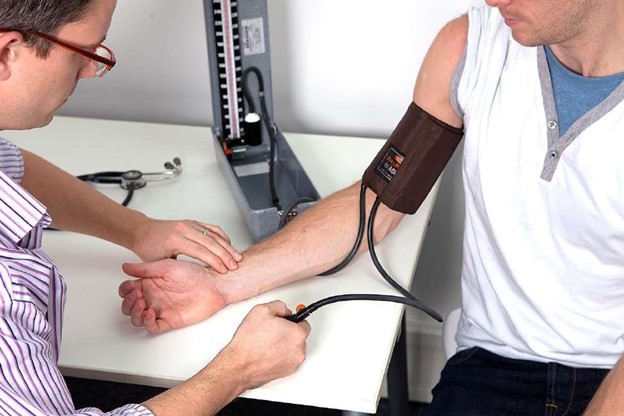A nurse is obtaining a client’s manual blood pressure and is having difficulty auscultating sounds.
Which of the following actions should the nurse take?
Apply the largest cuff available.
Use the palpatory method to determine blood pressure.
Place the arm above the level of the client’s heart.
Deflate the cuff quickly.
The Correct Answer is B
This method involves feeling the radial pulse while inflating and deflating the cuff.

The systolic pressure is estimated by noting the pressure at which the pulse disappears and reappears. The diastolic pressure is not measured by this method, but it can be useful when the sounds are difficult to hear.
Choice A is wrong because applying the largest cuff available can result in a falsely low reading. The cuff size should be appropriate for the client’s arm circumference.
Choice C is wrong because placing the arm above the level of the client’s heart can also cause a falsely low reading. The arm should be at the level of the heart for an accurate measurement.
Choice D is wrong because deflating the cuff quickly can lead to missing or skipping sounds, resulting in an inaccurate reading. The cuff should be deflated slowly and evenly.
Normal ranges for blood pressure vary depending on age, sex, and health conditions, but generally, a systolic pressure below 120 mmHg and a diastolic pressure below 80 mmHg are considered normal for adults.
Nursing Test Bank
Naxlex Comprehensive Predictor Exams
Related Questions
Correct Answer is C
Explanation
The nurse should ask the client what the voices are telling them, because this can help assess the client’s risk for harm to self or others, and also show empathy and respect for the client’s experience.
choice A:
The nurse should not assume that the client’s hallucinations are related to medication noncompliance, as this can be perceived as accusatory and judgmental.
choice B
The nurse should not focus on the duration of the hallucinations, as this is not the priority at this time.
choice D
The nurse should not invalidate the client’s reality by stating that they do not hear anything, as this can cause mistrust and alienation.
The nurse should use therapeutic communication techniques to establish rapport and safety with the client who has schizophrenia.
Correct Answer is D
Explanation
This action helps the client feel more comfortable and less intimidated by the nurse. It also allows the nurse to observe the client’s swallowing and signs of aspiration more easily.
Choice A is wrong because talking with the client during her feeding can distract her from swallowing properly and increase the risk of aspiration.
The nurse should encourage the client to focus on eating and avoid conversation until the feeding is over.
Choice B is wrong because discouraging the client from coughing during feedings can prevent her from clearing her airway and expelling any food particles that might have entered the trachea.
The nurse should monitor the client for coughing, choking, or changes in voice quality, which are indicators of aspiration.
Choice C is wrong because instructing the client to lift her chin when swallowing can actually make swallowing more difficult and increase the risk of aspiration.
The nurse should instruct the client to tuck her chin when swallowing, which helps close off the trachea and direct food into the esophagus.
Whether you are a student looking to ace your exams or a practicing nurse seeking to enhance your expertise , our nursing education contents will empower you with the confidence and competence to make a difference in the lives of patients and become a respected leader in the healthcare field.
Visit Naxlex, invest in your future and unlock endless possibilities with our unparalleled nursing education contents today
Report Wrong Answer on the Current Question
Do you disagree with the answer? If yes, what is your expected answer? Explain.
Kindly be descriptive with the issue you are facing.
